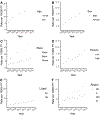Increasing rates of parathyroidectomy to treat secondary hyperparathyroidism in dialysis patients with Medicare coverage
- PMID: 35314072
- PMCID: PMC9233023
- DOI: 10.1016/j.surg.2022.02.005
Increasing rates of parathyroidectomy to treat secondary hyperparathyroidism in dialysis patients with Medicare coverage
Erratum in
-
Corrigendum to: Increasing rates of parathyroidectomy to treat secondary hyperparathyroidism in dialysis patients with Medicare coverage, Surgery, Volume 172, Issue 1, July 2022, pages 118-126.Surgery. 2023 Feb;173(2):560. doi: 10.1016/j.surg.2022.11.012. Epub 2022 Nov 26. Surgery. 2023. PMID: 36446662 No abstract available.
Abstract
Background: Secondary hyperparathyroidism affects nearly all patients with renal failure on dialysis. Medical treatment of secondary hyperparathyroidism has considerably evolved over the past 2 decades, with parathyroidectomy reserved for severe cases. The primary objective of our study was to understand how trends in medical treatments affected parathyroidectomy rates in patients with secondary hyperparathyroidism on dialysis.
Methods: We used the United States Renal Data System to identify 379,835 adult patients (age ≥18) who were on maintenance dialysis in the United States between 2006 and 2016 with Medicare as the primary payor and ascertained treatment for secondary hyperparathyroidism. Adjusted rate ratios for rates of parathyroidectomy were calculated using multivariable-adjusted Poisson regression.
Results: Of 379,835 secondary hyperparathyroidism patients, 4,118 (1.1%) underwent parathyroidectomy, 39,835 (10.5%) received cinacalcet, 243,522 (64.1%) received phosphate binders, 17,571 (4.6%) received vitamin D analogs, and 86,899 (22.9%) received no treatment during the 10 years of follow-up. Over the entire study period, there was a 3.5-fold increase in the use of calcimimetics and a 3.4-fold increase in rates of parathyroidectomy. Compared to 2006 through 2009, utilization of parathyroidectomy increased 52% (adjusted rate ratio = 1.52, 95% confidence interval: 1.39-1.65) between 2010 and 2013 and by 106% (adjusted rate ratio = 2.06, 95% confidence interval: 1.90-2.24) between 2014 and 2016. The greatest increase in parathyroidectomy utilization occurred in younger patients (age 18-64 years), Black patients, female patients, those living in higher poverty neighborhoods, those listed for kidney transplant, and those who live in the Southern region of the United States.
Conclusion: Despite the evolution of medical treatments and an increase in the use of calcimimetics to treat secondary hyperparathyroidism, parathyroidectomy rates have been steadily increasing among dialysis patients with Medicare coverage.
Copyright © 2022. Published by Elsevier Inc.
Conflict of interest statement
Conflict of Interest/Disclosures
The authors’ have no conflicts of interest to declare.
Figures






References
-
- Ketteler M, Block GA, Evenepoel P, Fukagawa M, Herzog CA, McCann L, Moe SM, Shroff R, Tonelli MA, Toussaint ND, Vervloet MG, Leonard MB 2017. Executive summary of the 2017 KDIGO Chronic Kidney Disease-Mineral and Bone Disorder (CKD-MBD) Guideline Update: what’s changed and why it matters. Kidney Int 92:26–36. - PubMed
-
- Kalantar-Zadeh K, Kuwae N, Regidor DL, Kovesdy CP, Kilpatrick RD, Shinaberger CS, McAllister CJ, Budoff MJ, Salusky IB, Kopple JD 2006. Survival predictability of time-varying indicators of bone disease in maintenance hemodialysis patients. Kidney Int 70:771–780. - PubMed
-
- Investigators ET, Chertow GM, Block GA, Correa-Rotter R, Drueke TB, Floege J, Goodman WG, Herzog CA, Kubo Y, London GM, Mahaffey KW, Mix TC, Moe SM, Trotman ML, Wheeler DC, Parfrey PS 2012. Effect of cinacalcet on cardiovascular disease in patients undergoing dialysis. N Engl J Med 367:2482–2494. - PubMed
Publication types
MeSH terms
Substances
Grants and funding
LinkOut - more resources
Full Text Sources
Medical
Miscellaneous

